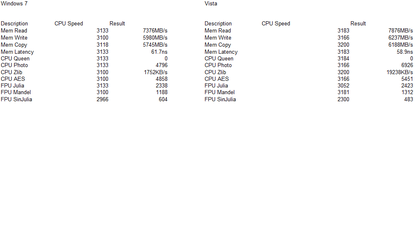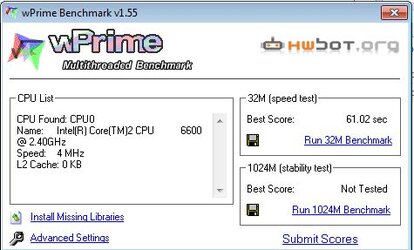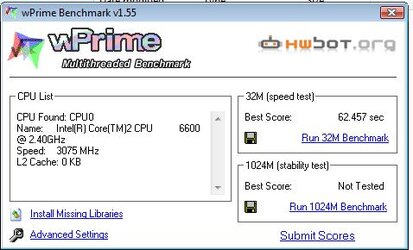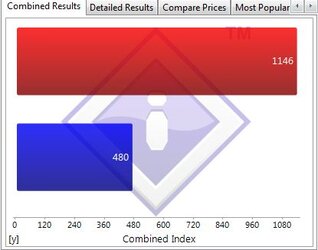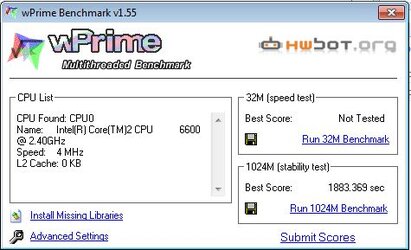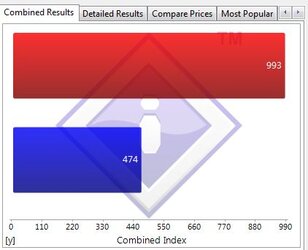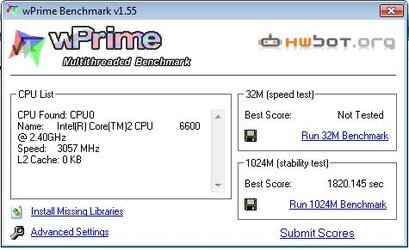- Joined
- May 30, 2004
I've held the position that Vista and Win7 were just about equal in performance. I was challenged on this, so now I have a couple of benchmarks. I used Everest, and Geekbench. PCmark05 and CrystalMark wouldn't run. wPrime_155 was taking too long so I bailed on that. If any of you really want to see it, I guess I can run that, but it may take a day or so.
Both O/Ss were in VMs using MS VirtualPC07. They were installed using default settings, but not activated, and virtual machine additions were installed. Vista32 Business was updated to SP1, and all essential updates were installed. Win7-32 Professional had all essential updates installed. Both VMs were defragged after update using the built in defragger. I gave them both 1gb of ram for the VMs. I thought it would be interesting seeing the results on a low spec machine. I disabled the sidebar in Vista, but otherwise it was an "as installed" system.
I haven't compared the benches myself yet, so as soon as I get them here, it'll be news to me also :^D
So here we go...
Windows 7
Everest(I trimmed the comparison machines)
--------[ EVEREST Ultimate Edition ]------------------------------------------------------------------------------------
Version EVEREST v4.60.1500
Benchmark Module 2.3.237.0
Homepage http://www.lavalys.com/
Report Type Report Wizard [ TRIAL VERSION ]
Computer WIN7VM-PC
Generator win7vm
Operating System Windows 7 Professional Media Center Edition 6.1.7600
Date 2009-10-28
Time 19:25
--------[ Summary ]-----------------------------------------------------------------------------------------------------
Computer:
Computer Type Advanced Configuration and Power Interface (ACPI) PC
Operating System Windows 7 Professional Media Center Edition
OS Service Pack [ TRIAL VERSION ]
Internet Explorer 8.0.7600.16385
DirectX DirectX 10.0
Computer Name WIN7VM-PC
User Name win7vm
Logon Domain [ TRIAL VERSION ]
Date / Time 2009-10-28 / 19:25
Motherboard:
CPU Type DualCore Intel Core 2 Duo, 3100 MHz
Motherboard Name Microsoft Virtual Machine
Motherboard Chipset Intel 82440BX/ZX
System Memory [ TRIAL VERSION ]
BIOS Type AMI (02/22/06)
Communication Port Communications Port (COM1)
Communication Port Communications Port (COM2)
Communication Port Printer Port (LPT1)
Display:
Video Adapter VM Additions S3 Trio32/64 (8 MB)
Multimedia:
Audio Adapter Multimedia Audio Controller [1414-0007] [NoDB]
Storage:
IDE Controller Intel(R) 82371AB/EB PCI Bus Master IDE Controller
Floppy Drive Floppy disk drive
Disk Drive Virtual HD ATA Device (15 GB, IDE)
Optical Drive MS C/DVD-ROM ATA Device (Virtual DVD-ROM)
SMART Hard Disks Status FAIL
Partitions:
C: (NTFS) [ TRIAL VERSION ]
Total Size [ TRIAL VERSION ]
Input:
Keyboard Standard PS/2 Keyboard
Mouse Microsoft PS/2 Mouse
Network:
Primary IP Address [ TRIAL VERSION ]
Primary MAC Address 00-03-FF-05-40-23
Network Adapter Intel 21140-Based PCI Fast Ethernet Adapter (Emulated) (192. [ TRIAL VERSION ])
Peripherals:
Printer Fax
Printer Microsoft XPS Document Writer
DMI:
DMI BIOS Vendor American Megatrends Inc.
DMI BIOS Version 080002
DMI System Manufacturer Microsoft Corporation
DMI System Product Virtual Machine
DMI System Version VS2005R2
DMI System Serial Number [ TRIAL VERSION ]
DMI System UUID [ TRIAL VERSION ]
DMI Motherboard Manufacturer Microsoft Corporation
DMI Motherboard Product Virtual Machine
DMI Motherboard Version 5.0
DMI Motherboard Serial Number [ TRIAL VERSION ]
DMI Chassis Manufacturer Microsoft Corporation
DMI Chassis Version 5.0
DMI Chassis Serial Number [ TRIAL VERSION ]
DMI Chassis Asset Tag [ TRIAL VERSION ]
DMI Chassis Type Desktop Case
DMI Total / Free Memory Sockets 4 / 0
--------[ Memory Read ]-------------------------------------------------------------------------------------------------
Core 2 Duo 3133 MHz [ TRIAL VERSION ] i440BX/ZX Dual EDO 7376 MB/s
--------[ Memory Write ]------------------------------------------------------------------------------------------------
Core 2 Duo 3100 MHz [ TRIAL VERSION ] i440BX/ZX Dual EDO 5980 MB/s
--------[ Memory Copy ]-------------------------------------------------------------------------------------------------
Core 2 Duo 3118 MHz [ TRIAL VERSION ] i440BX/ZX Dual EDO 5745 MB/s
--------[ Memory Latency ]----------------------------------------------------------------------------------------------
Core 2 Duo 3133 MHz [ TRIAL VERSION ] i440BX/ZX Dual EDO 61.7 ns
--------[ CPU Queen ]---------------------------------------------------------------------------------------------------
Core 2 Duo 3133 MHz [ TRIAL VERSION ] i440BX/ZX Dual EDO 0
--------[ CPU PhotoWorxx ]----------------------------------------------------------------------------------------------
Core 2 Duo 3133 MHz [ TRIAL VERSION ] i440BX/ZX Dual EDO 4796
--------[ CPU ZLib ]----------------------------------------------------------------------------------------------------
Core 2 Duo 3100 MHz [ TRIAL VERSION ] i440BX/ZX Dual EDO 17542 KB/s
--------[ CPU AES ]-----------------------------------------------------------------------------------------------------
8x
Core 2 Duo 3100 MHz [ TRIAL VERSION ] i440BX/ZX Dual EDO 4858
--------[ FPU Julia ]---------------------------------------------------------------------------------------------------
Core 2 Duo 3133 MHz [ TRIAL VERSION ] i440BX/ZX Dual EDO 2338
--------[ FPU Mandel ]--------------------------------------------------------------------------------------------------
Core 2 Duo 3100 MHz [ TRIAL VERSION ] i440BX/ZX Dual EDO 1188
--------[ FPU SinJulia ]------------------------------------------------------------------------------------------------
Core 2 Duo 2966 MHz [ TRIAL VERSION ] i440BX/ZX Dual EDO 604
GeekBench
Summary
Section Description Score Geekbench Score
Geekbench 2.1.4 for Windows x86 (32-bit)
Integer Processor integer performance 2687 2131
Floating Point Processor floating point performance 2389
Memory Memory performance 1128
Stream Memory bandwidth performance 1289
System Information
Operating System Microsoft Windows 7 Professional
Model Microsoft Corporation Virtual Machine Motherboard Microsoft Corporation Virtual Machine
Processor Intel(R) Core(TM)2 CPU 6600 @ 2.40GHz
Processor ID GenuineIntel Family 6 Model 15 Stepping 6
Processors 1 Threads 1
Cores 1 Memory 1024 MB SDRAM 0 MHz
Processor Frequency 5.00 MHz Bus Frequency 100.0 MHz
L1 Instruction Cache 0.00 B L1 Data Cache 0.00 B
L2 Cache 4.00 MB L3 Cache 0.00 B
BIOS American Megatrends Inc. 080002
Integer Section
Section Score 2687
Blowfish
single-threaded scalar 1776
78.1 MB/sec
Blowfish
multi-threaded scalar 1885
77.3 MB/sec
Text Compress
single-threaded scalar 2473
7.91 MB/sec
Text Compress
multi-threaded scalar 2258
7.41 MB/sec
Text Decompress
single-threaded scalar 2904
11.9 MB/sec
Text Decompress
multi-threaded scalar 2778
11.1 MB/sec
Image Compress
single-threaded scalar 2566
21.2 Mpixels/sec
Image Compress
multi-threaded scalar 2335
19.6 Mpixels/sec
Image Decompress
single-threaded scalar 2240
37.6 Mpixels/sec
Image Decompress
multi-threaded scalar 2169
35.4 Mpixels/sec
Lua
single-threaded scalar 4465
1.72 Mnodes/sec
Lua
multi-threaded scalar 4406
1.69 Mnodes/sec
Floating Point Section
Section Score 2389
Mandelbrot
single-threaded scalar 1983
1.32 Gflops
Mandelbrot
multi-threaded scalar 2177
1.42 Gflops
Dot Product
single-threaded scalar 1345
650.3 Mflops
Dot Product
multi-threaded scalar 1391
634.0 Mflops
Dot Product
single-threaded vector 3370
4.04 Gflops
Dot Product
multi-threaded vector 4405
4.58 Gflops
LU Decomposition
single-threaded scalar 2565
2.28 Gflops
LU Decomposition
multi-threaded scalar 2640
2.32 Gflops
Primality Test
single-threaded scalar 4019
600.2 Mflops
Primality Test
multi-threaded scalar 3080
571.6 Mflops
Sharpen Image
single-threaded scalar 651
1.52 Mpixels/sec
Sharpen Image
multi-threaded scalar 636
1.47 Mpixels/sec
Blur Image
single-threaded scalar 2568
2.03 Mpixels/sec
Blur Image
multi-threaded scalar 2617
2.06 Mpixels/sec
Memory Section
Section Score 1128
Read Sequential
single-threaded scalar 1377
1.69 GB/sec
Write Sequential
single-threaded scalar 1764
1.21 GB/sec
Stdlib Allocate
single-threaded scalar 882
3.29 Mallocs/sec
Stdlib Write
single-threaded scalar 534
1.11 GB/sec
Stdlib Copy
single-threaded scalar 1086
1.12 GB/sec
Stream Section
Section Score 1289
Stream Copy
single-threaded scalar 1328
1.82 GB/sec
Stream Copy
single-threaded vector 1620
2.10 GB/sec
Stream Scale
single-threaded scalar 995
1.29 GB/sec
Stream Scale
single-threaded vector 979
1.32 GB/sec
Stream Add
single-threaded scalar 1115
1.68 GB/sec
Stream Add
single-threaded vector 1180
1.64 GB/sec
Stream Triad
single-threaded scalar 1251
1.73 GB/sec
Stream Triad
single-threaded vector 1849
3.46 GB/sec
http://browse.geekbench.ca/geekbench2/view/179280
Vista
Everest(trimmed comparisons again)
--------[ EVEREST Ultimate Edition ]------------------------------------------------------------------------------------
Version EVEREST v4.60.1500
Benchmark Module 2.3.237.0
Homepage http://www.lavalys.com/
Report Type Report Wizard [ TRIAL VERSION ]
Computer VISTAVM-PC
Generator vistavm
Operating System Microsoft Windows Vista Business 6.0.6000 (Vista Retail)
Date 2009-10-28
Time 20:53
--------[ Summary ]-----------------------------------------------------------------------------------------------------
Computer:
Computer Type Advanced Configuration and Power Interface (ACPI) PC
Operating System Microsoft Windows Vista Business
OS Service Pack [ TRIAL VERSION ]
Internet Explorer 7.0.6000.16916
DirectX DirectX 10.0
Computer Name VISTAVM-PC
User Name vistavm
Logon Domain [ TRIAL VERSION ]
Date / Time 2009-10-28 / 20:53
Motherboard:
CPU Type DualCore Intel Core 2 Duo, 3166 MHz
Motherboard Name Microsoft Virtual Machine
Motherboard Chipset Intel 82440BX/ZX
System Memory [ TRIAL VERSION ]
BIOS Type AMI (02/22/06)
Communication Port Communications Port (COM1)
Communication Port Communications Port (COM2)
Communication Port Printer Port (LPT1)
Display:
Video Adapter VM Additions S3 Trio32/64 (8 MB)
Multimedia:
Audio Adapter Microsoft Virtual Machine Audio Device Driver [1414-0007] [NoDB]
Storage:
IDE Controller Intel(R) 82371AB/EB PCI Bus Master IDE Controller
Storage Controller Microsoft iSCSI Initiator
Floppy Drive Floppy disk drive
Disk Drive Virtual HD ATA Device (63 GB, IDE)
Optical Drive MS C/DVD-ROM ATA Device (Virtual DVD-ROM)
SMART Hard Disks Status FAIL
Partitions:
C: (NTFS) [ TRIAL VERSION ]
Total Size [ TRIAL VERSION ]
Input:
Keyboard Standard PS/2 Keyboard
Mouse Microsoft PS/2 Mouse
Network:
Primary IP Address [ TRIAL VERSION ]
Primary MAC Address 00-03-FF-04-40-23
Network Adapter Intel 21140-Based PCI Fast Ethernet Adapter (Emulated) (192. [ TRIAL VERSION ])
Peripherals:
Printer Fax
Printer Microsoft XPS Document Writer
DMI:
DMI BIOS Vendor American Megatrends Inc.
DMI BIOS Version 080002
DMI System Manufacturer Microsoft Corporation
DMI System Product Virtual Machine
DMI System Version VS2005R2
DMI System Serial Number [ TRIAL VERSION ]
DMI System UUID [ TRIAL VERSION ]
DMI Motherboard Manufacturer Microsoft Corporation
DMI Motherboard Product Virtual Machine
DMI Motherboard Version 5.0
DMI Motherboard Serial Number [ TRIAL VERSION ]
DMI Chassis Manufacturer Microsoft Corporation
DMI Chassis Version 5.0
DMI Chassis Serial Number [ TRIAL VERSION ]
DMI Chassis Asset Tag [ TRIAL VERSION ]
DMI Chassis Type Desktop Case
DMI Total / Free Memory Sockets 4 / 0
--------[ Memory Read ]-------------------------------------------------------------------------------------------------
Core 2 Duo 3183 MHz [ TRIAL VERSION ] i440BX/ZX Dual EDO 7876 MB/s
--------[ Memory Write ]------------------------------------------------------------------------------------------------
Core 2 Duo 3166 MHz [ TRIAL VERSION ] i440BX/ZX Dual EDO 6237 MB/s
--------[ Memory Copy ]-------------------------------------------------------------------------------------------------
Core 2 Duo 3200 MHz [ TRIAL VERSION ] i440BX/ZX Dual EDO 6188 MB/s
--------[ Memory Latency ]----------------------------------------------------------------------------------------------
Core 2 Duo 3183 MHz [ TRIAL VERSION ] i440BX/ZX Dual EDO 58.9 ns
--------[ CPU Queen ]---------------------------------------------------------------------------------------------------
Core 2 Duo 3184 MHz [ TRIAL VERSION ] i440BX/ZX Dual EDO 0
--------[ CPU PhotoWorxx ]----------------------------------------------------------------------------------------------
Core 2 Duo 3166 MHz [ TRIAL VERSION ] i440BX/ZX Dual EDO 6926
--------[ CPU ZLib ]----------------------------------------------------------------------------------------------------
Core 2 Duo 3200 MHz [ TRIAL VERSION ] i440BX/ZX Dual EDO 19238 KB/s
--------[ CPU AES ]-----------------------------------------------------------------------------------------------------
Core 2 Duo 3166 MHz [ TRIAL VERSION ] i440BX/ZX Dual EDO 5451
--------[ FPU Julia ]---------------------------------------------------------------------------------------------------
Core 2 Duo 3052 MHz [ TRIAL VERSION ] i440BX/ZX Dual EDO 2423
--------[ FPU Mandel ]--------------------------------------------------------------------------------------------------
Core 2 Duo 3181 MHz [ TRIAL VERSION ] i440BX/ZX Dual EDO 1312
--------[ FPU SinJulia ]------------------------------------------------------------------------------------------------
Core 2 Duo 2300 MHz [ TRIAL VERSION ] i440BX/ZX Dual EDO 483
GeekBench
Summary
Section Description Score Geekbench Score
Geekbench 2.1.4 for Windows x86 (32-bit)
Integer Processor integer performance 2656 2127
Floating Point Processor floating point performance 2345
Memory Memory performance 1309
Stream Memory bandwidth performance 1151
System Information
Operating System Microsoft Windows Vista Business
Model Microsoft Corporation Virtual Machine Motherboard Microsoft Corporation Virtual Machine
Processor Intel(R) Core(TM)2 CPU 6600 @ 2.40GHz
Processor ID GenuineIntel Family 6 Model 15 Stepping 6
Processors 1 Threads 1
Cores 1 Memory 1023 MB SDRAM 0 MHz
Processor Frequency 3.05 GHz Bus Frequency 100.0 MHz
L1 Instruction Cache 0.00 B L1 Data Cache 0.00 B
L2 Cache 4.00 MB L3 Cache 0.00 B
BIOS American Megatrends Inc. 080002
Integer Section
Section Score 2656
Blowfish
single-threaded scalar 1787
78.5 MB/sec
Blowfish
multi-threaded scalar 1923
78.8 MB/sec
Text Compress
single-threaded scalar 2445
7.82 MB/sec
Text Compress
multi-threaded scalar 2434
7.99 MB/sec
Text Decompress
single-threaded scalar 2691
11.1 MB/sec
Text Decompress
multi-threaded scalar 2791
11.1 MB/sec
Image Compress
single-threaded scalar 2368
19.6 Mpixels/sec
Image Compress
multi-threaded scalar 2416
20.3 Mpixels/sec
Image Decompress
single-threaded scalar 1716
28.8 Mpixels/sec
Image Decompress
multi-threaded scalar 2012
32.8 Mpixels/sec
Lua
single-threaded scalar 4698
1.81 Mnodes/sec
Lua
multi-threaded scalar 4591
1.77 Mnodes/sec
Floating Point Section
Section Score 2345
Mandelbrot
single-threaded scalar 2454
1.63 Gflops
Mandelbrot
multi-threaded scalar 1991
1.30 Gflops
Dot Product
single-threaded scalar 1339
647.0 Mflops
Dot Product
multi-threaded scalar 1391
633.9 Mflops
Dot Product
single-threaded vector 3109
3.73 Gflops
Dot Product
multi-threaded vector 4033
4.19 Gflops
LU Decomposition
single-threaded scalar 2445
2.18 Gflops
LU Decomposition
multi-threaded scalar 2503
2.20 Gflops
Primality Test
single-threaded scalar 3830
572.0 Mflops
Primality Test
multi-threaded scalar 3129
580.8 Mflops
Sharpen Image
single-threaded scalar 633
1.48 Mpixels/sec
Sharpen Image
multi-threaded scalar 641
1.48 Mpixels/sec
Blur Image
single-threaded scalar 2699
2.14 Mpixels/sec
Blur Image
multi-threaded scalar 2639
2.08 Mpixels/sec
Memory Section
Section Score 1309
Read Sequential
single-threaded scalar 1601
1.96 GB/sec
Write Sequential
single-threaded scalar 1707
1.17 GB/sec
Stdlib Allocate
single-threaded scalar 950
3.55 Mallocs/sec
Stdlib Write
single-threaded scalar 952
1.97 GB/sec
Stdlib Copy
single-threaded scalar 1335
1.38 GB/sec
Stream Section
Section Score 1151
Stream Copy
single-threaded scalar 964
1.32 GB/sec
Stream Copy
single-threaded vector 1059
1.37 GB/sec
Stream Scale
single-threaded scalar 1003
1.30 GB/sec
Stream Scale
single-threaded vector 1264
1.71 GB/sec
Stream Add
single-threaded scalar 873
1.32 GB/sec
Stream Add
single-threaded vector 1038
1.44 GB/sec
Stream Triad
single-threaded scalar 2258
3.12 GB/sec
Stream Triad
single-threaded vector 751
1.41 GB/sec
http://browse.geekbench.ca/geekbench2/view/179297
Both O/Ss were in VMs using MS VirtualPC07. They were installed using default settings, but not activated, and virtual machine additions were installed. Vista32 Business was updated to SP1, and all essential updates were installed. Win7-32 Professional had all essential updates installed. Both VMs were defragged after update using the built in defragger. I gave them both 1gb of ram for the VMs. I thought it would be interesting seeing the results on a low spec machine. I disabled the sidebar in Vista, but otherwise it was an "as installed" system.
I haven't compared the benches myself yet, so as soon as I get them here, it'll be news to me also :^D
So here we go...
Windows 7
Everest(I trimmed the comparison machines)
--------[ EVEREST Ultimate Edition ]------------------------------------------------------------------------------------
Version EVEREST v4.60.1500
Benchmark Module 2.3.237.0
Homepage http://www.lavalys.com/
Report Type Report Wizard [ TRIAL VERSION ]
Computer WIN7VM-PC
Generator win7vm
Operating System Windows 7 Professional Media Center Edition 6.1.7600
Date 2009-10-28
Time 19:25
--------[ Summary ]-----------------------------------------------------------------------------------------------------
Computer:
Computer Type Advanced Configuration and Power Interface (ACPI) PC
Operating System Windows 7 Professional Media Center Edition
OS Service Pack [ TRIAL VERSION ]
Internet Explorer 8.0.7600.16385
DirectX DirectX 10.0
Computer Name WIN7VM-PC
User Name win7vm
Logon Domain [ TRIAL VERSION ]
Date / Time 2009-10-28 / 19:25
Motherboard:
CPU Type DualCore Intel Core 2 Duo, 3100 MHz
Motherboard Name Microsoft Virtual Machine
Motherboard Chipset Intel 82440BX/ZX
System Memory [ TRIAL VERSION ]
BIOS Type AMI (02/22/06)
Communication Port Communications Port (COM1)
Communication Port Communications Port (COM2)
Communication Port Printer Port (LPT1)
Display:
Video Adapter VM Additions S3 Trio32/64 (8 MB)
Multimedia:
Audio Adapter Multimedia Audio Controller [1414-0007] [NoDB]
Storage:
IDE Controller Intel(R) 82371AB/EB PCI Bus Master IDE Controller
Floppy Drive Floppy disk drive
Disk Drive Virtual HD ATA Device (15 GB, IDE)
Optical Drive MS C/DVD-ROM ATA Device (Virtual DVD-ROM)
SMART Hard Disks Status FAIL
Partitions:
C: (NTFS) [ TRIAL VERSION ]
Total Size [ TRIAL VERSION ]
Input:
Keyboard Standard PS/2 Keyboard
Mouse Microsoft PS/2 Mouse
Network:
Primary IP Address [ TRIAL VERSION ]
Primary MAC Address 00-03-FF-05-40-23
Network Adapter Intel 21140-Based PCI Fast Ethernet Adapter (Emulated) (192. [ TRIAL VERSION ])
Peripherals:
Printer Fax
Printer Microsoft XPS Document Writer
DMI:
DMI BIOS Vendor American Megatrends Inc.
DMI BIOS Version 080002
DMI System Manufacturer Microsoft Corporation
DMI System Product Virtual Machine
DMI System Version VS2005R2
DMI System Serial Number [ TRIAL VERSION ]
DMI System UUID [ TRIAL VERSION ]
DMI Motherboard Manufacturer Microsoft Corporation
DMI Motherboard Product Virtual Machine
DMI Motherboard Version 5.0
DMI Motherboard Serial Number [ TRIAL VERSION ]
DMI Chassis Manufacturer Microsoft Corporation
DMI Chassis Version 5.0
DMI Chassis Serial Number [ TRIAL VERSION ]
DMI Chassis Asset Tag [ TRIAL VERSION ]
DMI Chassis Type Desktop Case
DMI Total / Free Memory Sockets 4 / 0
--------[ Memory Read ]-------------------------------------------------------------------------------------------------
Core 2 Duo 3133 MHz [ TRIAL VERSION ] i440BX/ZX Dual EDO 7376 MB/s
--------[ Memory Write ]------------------------------------------------------------------------------------------------
Core 2 Duo 3100 MHz [ TRIAL VERSION ] i440BX/ZX Dual EDO 5980 MB/s
--------[ Memory Copy ]-------------------------------------------------------------------------------------------------
Core 2 Duo 3118 MHz [ TRIAL VERSION ] i440BX/ZX Dual EDO 5745 MB/s
--------[ Memory Latency ]----------------------------------------------------------------------------------------------
Core 2 Duo 3133 MHz [ TRIAL VERSION ] i440BX/ZX Dual EDO 61.7 ns
--------[ CPU Queen ]---------------------------------------------------------------------------------------------------
Core 2 Duo 3133 MHz [ TRIAL VERSION ] i440BX/ZX Dual EDO 0
--------[ CPU PhotoWorxx ]----------------------------------------------------------------------------------------------
Core 2 Duo 3133 MHz [ TRIAL VERSION ] i440BX/ZX Dual EDO 4796
--------[ CPU ZLib ]----------------------------------------------------------------------------------------------------
Core 2 Duo 3100 MHz [ TRIAL VERSION ] i440BX/ZX Dual EDO 17542 KB/s
--------[ CPU AES ]-----------------------------------------------------------------------------------------------------
8x
Core 2 Duo 3100 MHz [ TRIAL VERSION ] i440BX/ZX Dual EDO 4858
--------[ FPU Julia ]---------------------------------------------------------------------------------------------------
Core 2 Duo 3133 MHz [ TRIAL VERSION ] i440BX/ZX Dual EDO 2338
--------[ FPU Mandel ]--------------------------------------------------------------------------------------------------
Core 2 Duo 3100 MHz [ TRIAL VERSION ] i440BX/ZX Dual EDO 1188
--------[ FPU SinJulia ]------------------------------------------------------------------------------------------------
Core 2 Duo 2966 MHz [ TRIAL VERSION ] i440BX/ZX Dual EDO 604
GeekBench
Summary
Section Description Score Geekbench Score
Geekbench 2.1.4 for Windows x86 (32-bit)
Integer Processor integer performance 2687 2131
Floating Point Processor floating point performance 2389
Memory Memory performance 1128
Stream Memory bandwidth performance 1289
System Information
Operating System Microsoft Windows 7 Professional
Model Microsoft Corporation Virtual Machine Motherboard Microsoft Corporation Virtual Machine
Processor Intel(R) Core(TM)2 CPU 6600 @ 2.40GHz
Processor ID GenuineIntel Family 6 Model 15 Stepping 6
Processors 1 Threads 1
Cores 1 Memory 1024 MB SDRAM 0 MHz
Processor Frequency 5.00 MHz Bus Frequency 100.0 MHz
L1 Instruction Cache 0.00 B L1 Data Cache 0.00 B
L2 Cache 4.00 MB L3 Cache 0.00 B
BIOS American Megatrends Inc. 080002
Integer Section
Section Score 2687
Blowfish
single-threaded scalar 1776
78.1 MB/sec
Blowfish
multi-threaded scalar 1885
77.3 MB/sec
Text Compress
single-threaded scalar 2473
7.91 MB/sec
Text Compress
multi-threaded scalar 2258
7.41 MB/sec
Text Decompress
single-threaded scalar 2904
11.9 MB/sec
Text Decompress
multi-threaded scalar 2778
11.1 MB/sec
Image Compress
single-threaded scalar 2566
21.2 Mpixels/sec
Image Compress
multi-threaded scalar 2335
19.6 Mpixels/sec
Image Decompress
single-threaded scalar 2240
37.6 Mpixels/sec
Image Decompress
multi-threaded scalar 2169
35.4 Mpixels/sec
Lua
single-threaded scalar 4465
1.72 Mnodes/sec
Lua
multi-threaded scalar 4406
1.69 Mnodes/sec
Floating Point Section
Section Score 2389
Mandelbrot
single-threaded scalar 1983
1.32 Gflops
Mandelbrot
multi-threaded scalar 2177
1.42 Gflops
Dot Product
single-threaded scalar 1345
650.3 Mflops
Dot Product
multi-threaded scalar 1391
634.0 Mflops
Dot Product
single-threaded vector 3370
4.04 Gflops
Dot Product
multi-threaded vector 4405
4.58 Gflops
LU Decomposition
single-threaded scalar 2565
2.28 Gflops
LU Decomposition
multi-threaded scalar 2640
2.32 Gflops
Primality Test
single-threaded scalar 4019
600.2 Mflops
Primality Test
multi-threaded scalar 3080
571.6 Mflops
Sharpen Image
single-threaded scalar 651
1.52 Mpixels/sec
Sharpen Image
multi-threaded scalar 636
1.47 Mpixels/sec
Blur Image
single-threaded scalar 2568
2.03 Mpixels/sec
Blur Image
multi-threaded scalar 2617
2.06 Mpixels/sec
Memory Section
Section Score 1128
Read Sequential
single-threaded scalar 1377
1.69 GB/sec
Write Sequential
single-threaded scalar 1764
1.21 GB/sec
Stdlib Allocate
single-threaded scalar 882
3.29 Mallocs/sec
Stdlib Write
single-threaded scalar 534
1.11 GB/sec
Stdlib Copy
single-threaded scalar 1086
1.12 GB/sec
Stream Section
Section Score 1289
Stream Copy
single-threaded scalar 1328
1.82 GB/sec
Stream Copy
single-threaded vector 1620
2.10 GB/sec
Stream Scale
single-threaded scalar 995
1.29 GB/sec
Stream Scale
single-threaded vector 979
1.32 GB/sec
Stream Add
single-threaded scalar 1115
1.68 GB/sec
Stream Add
single-threaded vector 1180
1.64 GB/sec
Stream Triad
single-threaded scalar 1251
1.73 GB/sec
Stream Triad
single-threaded vector 1849
3.46 GB/sec
http://browse.geekbench.ca/geekbench2/view/179280
Vista
Everest(trimmed comparisons again)
--------[ EVEREST Ultimate Edition ]------------------------------------------------------------------------------------
Version EVEREST v4.60.1500
Benchmark Module 2.3.237.0
Homepage http://www.lavalys.com/
Report Type Report Wizard [ TRIAL VERSION ]
Computer VISTAVM-PC
Generator vistavm
Operating System Microsoft Windows Vista Business 6.0.6000 (Vista Retail)
Date 2009-10-28
Time 20:53
--------[ Summary ]-----------------------------------------------------------------------------------------------------
Computer:
Computer Type Advanced Configuration and Power Interface (ACPI) PC
Operating System Microsoft Windows Vista Business
OS Service Pack [ TRIAL VERSION ]
Internet Explorer 7.0.6000.16916
DirectX DirectX 10.0
Computer Name VISTAVM-PC
User Name vistavm
Logon Domain [ TRIAL VERSION ]
Date / Time 2009-10-28 / 20:53
Motherboard:
CPU Type DualCore Intel Core 2 Duo, 3166 MHz
Motherboard Name Microsoft Virtual Machine
Motherboard Chipset Intel 82440BX/ZX
System Memory [ TRIAL VERSION ]
BIOS Type AMI (02/22/06)
Communication Port Communications Port (COM1)
Communication Port Communications Port (COM2)
Communication Port Printer Port (LPT1)
Display:
Video Adapter VM Additions S3 Trio32/64 (8 MB)
Multimedia:
Audio Adapter Microsoft Virtual Machine Audio Device Driver [1414-0007] [NoDB]
Storage:
IDE Controller Intel(R) 82371AB/EB PCI Bus Master IDE Controller
Storage Controller Microsoft iSCSI Initiator
Floppy Drive Floppy disk drive
Disk Drive Virtual HD ATA Device (63 GB, IDE)
Optical Drive MS C/DVD-ROM ATA Device (Virtual DVD-ROM)
SMART Hard Disks Status FAIL
Partitions:
C: (NTFS) [ TRIAL VERSION ]
Total Size [ TRIAL VERSION ]
Input:
Keyboard Standard PS/2 Keyboard
Mouse Microsoft PS/2 Mouse
Network:
Primary IP Address [ TRIAL VERSION ]
Primary MAC Address 00-03-FF-04-40-23
Network Adapter Intel 21140-Based PCI Fast Ethernet Adapter (Emulated) (192. [ TRIAL VERSION ])
Peripherals:
Printer Fax
Printer Microsoft XPS Document Writer
DMI:
DMI BIOS Vendor American Megatrends Inc.
DMI BIOS Version 080002
DMI System Manufacturer Microsoft Corporation
DMI System Product Virtual Machine
DMI System Version VS2005R2
DMI System Serial Number [ TRIAL VERSION ]
DMI System UUID [ TRIAL VERSION ]
DMI Motherboard Manufacturer Microsoft Corporation
DMI Motherboard Product Virtual Machine
DMI Motherboard Version 5.0
DMI Motherboard Serial Number [ TRIAL VERSION ]
DMI Chassis Manufacturer Microsoft Corporation
DMI Chassis Version 5.0
DMI Chassis Serial Number [ TRIAL VERSION ]
DMI Chassis Asset Tag [ TRIAL VERSION ]
DMI Chassis Type Desktop Case
DMI Total / Free Memory Sockets 4 / 0
--------[ Memory Read ]-------------------------------------------------------------------------------------------------
Core 2 Duo 3183 MHz [ TRIAL VERSION ] i440BX/ZX Dual EDO 7876 MB/s
--------[ Memory Write ]------------------------------------------------------------------------------------------------
Core 2 Duo 3166 MHz [ TRIAL VERSION ] i440BX/ZX Dual EDO 6237 MB/s
--------[ Memory Copy ]-------------------------------------------------------------------------------------------------
Core 2 Duo 3200 MHz [ TRIAL VERSION ] i440BX/ZX Dual EDO 6188 MB/s
--------[ Memory Latency ]----------------------------------------------------------------------------------------------
Core 2 Duo 3183 MHz [ TRIAL VERSION ] i440BX/ZX Dual EDO 58.9 ns
--------[ CPU Queen ]---------------------------------------------------------------------------------------------------
Core 2 Duo 3184 MHz [ TRIAL VERSION ] i440BX/ZX Dual EDO 0
--------[ CPU PhotoWorxx ]----------------------------------------------------------------------------------------------
Core 2 Duo 3166 MHz [ TRIAL VERSION ] i440BX/ZX Dual EDO 6926
--------[ CPU ZLib ]----------------------------------------------------------------------------------------------------
Core 2 Duo 3200 MHz [ TRIAL VERSION ] i440BX/ZX Dual EDO 19238 KB/s
--------[ CPU AES ]-----------------------------------------------------------------------------------------------------
Core 2 Duo 3166 MHz [ TRIAL VERSION ] i440BX/ZX Dual EDO 5451
--------[ FPU Julia ]---------------------------------------------------------------------------------------------------
Core 2 Duo 3052 MHz [ TRIAL VERSION ] i440BX/ZX Dual EDO 2423
--------[ FPU Mandel ]--------------------------------------------------------------------------------------------------
Core 2 Duo 3181 MHz [ TRIAL VERSION ] i440BX/ZX Dual EDO 1312
--------[ FPU SinJulia ]------------------------------------------------------------------------------------------------
Core 2 Duo 2300 MHz [ TRIAL VERSION ] i440BX/ZX Dual EDO 483
GeekBench
Summary
Section Description Score Geekbench Score
Geekbench 2.1.4 for Windows x86 (32-bit)
Integer Processor integer performance 2656 2127
Floating Point Processor floating point performance 2345
Memory Memory performance 1309
Stream Memory bandwidth performance 1151
System Information
Operating System Microsoft Windows Vista Business
Model Microsoft Corporation Virtual Machine Motherboard Microsoft Corporation Virtual Machine
Processor Intel(R) Core(TM)2 CPU 6600 @ 2.40GHz
Processor ID GenuineIntel Family 6 Model 15 Stepping 6
Processors 1 Threads 1
Cores 1 Memory 1023 MB SDRAM 0 MHz
Processor Frequency 3.05 GHz Bus Frequency 100.0 MHz
L1 Instruction Cache 0.00 B L1 Data Cache 0.00 B
L2 Cache 4.00 MB L3 Cache 0.00 B
BIOS American Megatrends Inc. 080002
Integer Section
Section Score 2656
Blowfish
single-threaded scalar 1787
78.5 MB/sec
Blowfish
multi-threaded scalar 1923
78.8 MB/sec
Text Compress
single-threaded scalar 2445
7.82 MB/sec
Text Compress
multi-threaded scalar 2434
7.99 MB/sec
Text Decompress
single-threaded scalar 2691
11.1 MB/sec
Text Decompress
multi-threaded scalar 2791
11.1 MB/sec
Image Compress
single-threaded scalar 2368
19.6 Mpixels/sec
Image Compress
multi-threaded scalar 2416
20.3 Mpixels/sec
Image Decompress
single-threaded scalar 1716
28.8 Mpixels/sec
Image Decompress
multi-threaded scalar 2012
32.8 Mpixels/sec
Lua
single-threaded scalar 4698
1.81 Mnodes/sec
Lua
multi-threaded scalar 4591
1.77 Mnodes/sec
Floating Point Section
Section Score 2345
Mandelbrot
single-threaded scalar 2454
1.63 Gflops
Mandelbrot
multi-threaded scalar 1991
1.30 Gflops
Dot Product
single-threaded scalar 1339
647.0 Mflops
Dot Product
multi-threaded scalar 1391
633.9 Mflops
Dot Product
single-threaded vector 3109
3.73 Gflops
Dot Product
multi-threaded vector 4033
4.19 Gflops
LU Decomposition
single-threaded scalar 2445
2.18 Gflops
LU Decomposition
multi-threaded scalar 2503
2.20 Gflops
Primality Test
single-threaded scalar 3830
572.0 Mflops
Primality Test
multi-threaded scalar 3129
580.8 Mflops
Sharpen Image
single-threaded scalar 633
1.48 Mpixels/sec
Sharpen Image
multi-threaded scalar 641
1.48 Mpixels/sec
Blur Image
single-threaded scalar 2699
2.14 Mpixels/sec
Blur Image
multi-threaded scalar 2639
2.08 Mpixels/sec
Memory Section
Section Score 1309
Read Sequential
single-threaded scalar 1601
1.96 GB/sec
Write Sequential
single-threaded scalar 1707
1.17 GB/sec
Stdlib Allocate
single-threaded scalar 950
3.55 Mallocs/sec
Stdlib Write
single-threaded scalar 952
1.97 GB/sec
Stdlib Copy
single-threaded scalar 1335
1.38 GB/sec
Stream Section
Section Score 1151
Stream Copy
single-threaded scalar 964
1.32 GB/sec
Stream Copy
single-threaded vector 1059
1.37 GB/sec
Stream Scale
single-threaded scalar 1003
1.30 GB/sec
Stream Scale
single-threaded vector 1264
1.71 GB/sec
Stream Add
single-threaded scalar 873
1.32 GB/sec
Stream Add
single-threaded vector 1038
1.44 GB/sec
Stream Triad
single-threaded scalar 2258
3.12 GB/sec
Stream Triad
single-threaded vector 751
1.41 GB/sec
http://browse.geekbench.ca/geekbench2/view/179297

